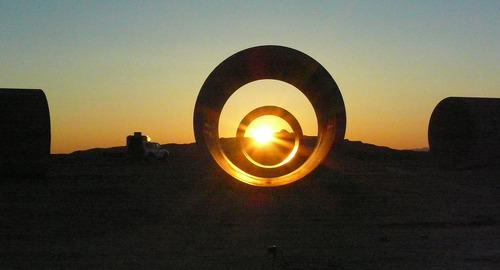This is an archived article that was published on sltrib.com in 2014, and information in the article may be outdated. It is provided only for personal research purposes and may not be reprinted.
Nancy Holt said her life changed forever when she landed at the Las Vegas airport with fellow artists Robert Smithson and Michael Heizer in 1968.
"The airport was out in this flat desert area, so I experienced the space of the West," the artist told The Salt Lake Tribune's Sean Means in 2012. "I was overwhelmed with it. It seemed to me that I had this Western space that had been within me. That was my inner reality. I was experiencing it on the outside, simultaneously with my spaciousness within. I felt at one."
Holt, whose best known work, the Sun Tunnels, stands in a remote part of Utah's West Desert about 40 miles north of Wendover, died of leukemia Saturday in New York City. She was 75.
The University of Manchester Whitworth Art Gallery in England called Holt "a pioneer in conceptual and public art" and a "key member of the Land Art movement, which began in the late 1960s with artists in New York taking their work out of the gallery and into the landscape."
The Sun Tunnels, which consist of four, 18-foot-long concrete tubes, were placed on land she and Smithson purchased in 1971. They are arranged to catch the rising and setting sun on the summer and winter solstices.
Gretchen Dietrich, the executive director of the Utah Museum of Fine Arts which staged a tribute to Holt in 2012 called "Nancy Holt: Sightlines," accompanied the artist on what was probably Holt's last visit to the Sun Tunnels.
"It was amazing," said Dietrich. "One thing I definitely remember is how happy she seemed. It was years before she was sick. She had not been there in awhile. She was so happy to be back there."
Dietrich called Holt an incredibly important artist who, because she was a woman and the wife of Spiral Jetty creator Robert Smithson, was underappreciated for many years.
"She recently received the attention she deserved," said Dietrich. "Our exhibition was super smart and super beautiful. It told the story of her role in Land Art as a seminal figure in Land Art in America … The Sun Tunnels makes Utah special. Just like the Spiral Jetty, it puts us on the art map of the world."
Matt Coolidge, director of the Center for Land Use Interpretation, was another Land Art enthusiast who traveled to the Sun Tunnels with Holt. He recalled running into two art students from France at the remote West Desert location. The pair recognized Holt immediately, and Coolidge remembers how generous the artist was in spending time with them.
"She was always a positive force," he said.
Coolidge called the period of the late 1960s and early 1970s the classic period of Land Art. Smithson, who died in a airplane crash in 1973 at the age of 35, installed the Spiral Jetty in 1970, while the Sun Tunnels were completed in 1976.
"It is interesting that it [the Sun Tunnels] sits on the opposite side of the lake from the Spiral Jetty," said Coolidge. "You have the more famous, assertive Robert Smithson sculpture on one side, and the more feminine kind of manifestation emerging on the west side of the lake with Nancy's work. You had the terrestrial work in the form of the Spiral Jetty and the more astronomical and astrological work of the Sun Tunnels on the other side. They complement each other really well in that way."
According to Means, Holt was among the first video artists and a pioneer in art photography. She was known for "concrete poetry" in which the typography and placement of the words on the page are as much a part of the art as the words themselves.
Means wrote that due to the success of the Sun Tunnels, Holt received commissions for other site-specific work in more populated areas.
Holt was once quoted as saying that "if work hangs in a gallery or museum, the art gets made for the spaces that were made to enclose art. They isolate objects, detach them from the world."
According to an obituary in The New York Times, Holt was born April 5, 1938, in Worcester, Mass., and was an only child. Her father was a chemical engineer and her mother was a homemaker. The Times said Holt studied biology at Tufts University and moved to New York, where she became involved in art.
Twitter: @tribtomwharton



